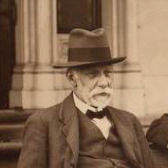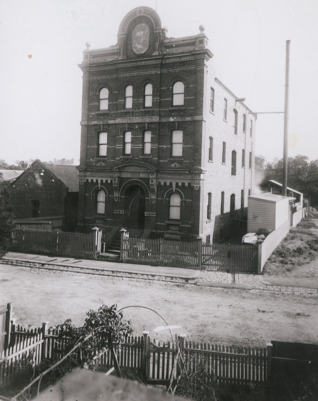Collingwood Notables Database
Thomas Baker
1854-1928
Manufacturing chemist, inventor, photographer, philanthropist
Thomas Baker was a well-known Abbotsford identity for many years, living at Yarra Grange in Southampton Crescent and establishing the firm of Baker and Rouse which became the largest supplier of photographic material in Australia. He eventually became managing director of Kodak (Australasia) which continued to operate on the Yarra Grange site and surrounds until the 1950s.
Thomas’s family had migrated to Adelaide in 1865. Thomas at first joined his father as a blacksmith, wheelwright and coachbuilder, but left to become a pharmaceutical chemist in Queensland in 1876. There he married Sydney-born Alice Shaw. By 1880 the couple had moved to Melbourne where Thomas began studying medicine in 1882, but discontinued the course to begin experimenting with the production of photographic dry plates. Until the 1880s, photography relied on the cumbersome and inconvenient wet plate process which had to be exposed at once and developed while wet. Baker was renting a house in South Audley Street Abbotsford when, in September 1884, the nearby property Yarra Grange was advertised for sale; on a site more than two acres, running from Southampton Crescent down to the Yarra River, the mansion had been re-built to the design of an earlier owner, James Smith, on the Pompeian plan, that is with a large central hall. Nine rooms opened off this hall, which was paved with Staffordshire encaustic tiles, and there was a variety of outbuildings, a cottage, a well-stocked garden, and a secluded environment, despite nearby industries. Baker apparently quickly snapped up the large property with its potential for combining home and work. By this time, Baker had mastered the dry-plate technique sufficiently to begin his own business, operating from a wholesale store in the city and setting up the Austral Plate Company in a laboratory at his new residence. In 1886 he engaged architect James Wood to design a brick factory on his land. A contemporary photograph shows an amazingly decorative three-storey plus basement brick building; next to it is a small building which would have been the original laboratory.
In 1887 Baker went into partnership with John Joseph Rouse as importers and producers of photographic material. Baker & Rouse prospered during this boom era for amateur and professional photography. The scientific Baker controlled the manufacturing process while Rouse, an accountant, set up a network of sales outlets. In 1908 the firm amalgamated with the Eastman Kodak Company to form Australian Kodak Limited, with Baker and Rouse as joint managing directors. In 1911 it was renamed Kodak (Australasia) Limited. Additional factories were built adjoining the 1886 laboratory; in 1924 the firm manufactured the first X-ray film in Australia.
His wife’s sister Eleanor Shaw and brother Alfred Shaw lived with the couple and had shares in the company, as did Mrs Baker. Alfred was a chemist and worked for Baker; Alice Baker assisted Thomas in his work but also became well-known for her social and philanthropic activities, most of which she carried out in conjunction with her sister.
Baker was like many Collingwood businessmen in residing near his works, but around 1919 the Bakers acquired Manyung in Mornington as their residence and thus ended an extensive period of work/home co-location.
Thomas Baker contributed to many charitable concerns, often anonymously, but in 1926 instigated a very public venture when the Baker Medical Research Institute (still continuing today as the Baker Heart & Diabetes Institute) was established at the Alfred Hospital with funds from Thomas and Alice Baker and Eleanor Shaw.
Kodak flourished and expanded to such an extent that it needed to move to Coburg in the 1950s. When the Coburg site closed in 2005 the company donated a huge quantity of material to the Museum of Victoria. There include hundreds of photos of the Abbotsford site; although none of them seems to provide a complete view of the old house, the manicured gardens are often in evidence in what must have been a pleasant working environment for the Kodak employees. While the nineteenth century buildings have since been demolished, some of the buildings now occupied by Carlton United Breweries would appear to be early twentieth remnants of the Kodak complex on the north side of Southampton Crescent, while the impressive 1928 building built by Kodak on the south side still exists, neatly following the curve of the street.
Austral Laboratory
Life Summary
| Birth Date | Birth Place |
|---|---|
| 1854 | Montacute, Somerset, England |
| Spouse Name | Date of Marriage | Children |
|---|---|---|
| Alice Shaw, 1855-1935 | 1877 | None |
| Home Street | Home City | Status of Building |
|---|---|---|
| 17 South Audley Street | Abbotsford | Demolished |
| Yarra Grange, Southampton Crescent | Abbotsford | Demolished |
| Death Date | Death Place | Cemetery |
|---|---|---|
| 4 December 1928 | Mornington, Victoria | Cremated at Fawkner |
The Argus; Table Talk; The Australasian; Barrett, The inner suburbs; From cottage industry to major company in Australia: milestones in the history of Kodak (Australasia) Pty Ltd.
https://www.baker.edu.au/who-we-are
Photograph of Thomas Baker courtesy Kodak of Australasia Pty Ltd


